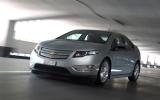The Chevrolet Volt is a mainstream electric car that’s essentially a rebadged version of the Vauxhall Ampera.
Based on GM’s Delta platform, which also underpins Chevrolet’s Cruze hatchback and the Vauxhall Astra, the Volt is a four-seat hatch powered by lithium ion batteries that can be recharged by plugging into the mains, or on the go by its on-board 1.4-litre petrol engine.
General Motors insists that the Volt is not a hybrid but an ‘extended range electric vehicle’. GM is confident the Volt will be capable of covering up to 40 miles on a single charge but, unlike every other EVs, fluctuations in range don’t really matter because the Volt can fire up its 1.4-litre petrol engine to charge its batteries and ensure there’s always drive to the front-wheels.
The electric motor is rated at 150bhp, and delivers a healthy 273lb ft of torque, or about the same as a 2.0-litre diesel. The most significant point is that the Volt is just like a normal hatchback to drive, with the added benefit of being very quiet. There’s virtually no noise when you press the illuminated start button and you only have to pull the shift lever into ‘D’ mode to make a silent getaway.
The smooth torque of the electric motor does a surprisingly good job of disguising the Volt’s 1715kg kerb weight. Its linear power delivery builds speed very smoothly and is helped by the fact that there are no gearchanges to interrupt progress.



















